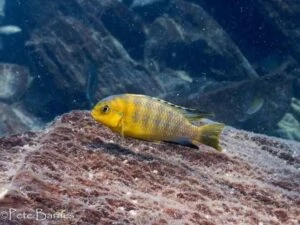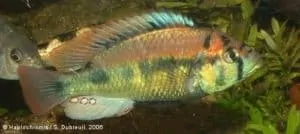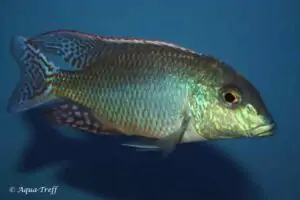Geophagus dicrozoster
The name Geophagus comes from 2 Greek words: Geos means earth and phagein means food. Dicrozoster also comes from Greek, which means split (dicros) belt (zoster). This refers to the 4th and 5th bands across the body that do not run straight up but together form a “Y” although sometimes the bands do not quite touch each other. Previously this species was known as Geophagus sp. “Colombia” and is one of the more colorful Geophagus species.
Geophagus dicrozoster is therefore an earth eater. With its downward-pointing mouth, they take bites of soil or sand into their mouth and sift out food particles with the help of their gills. A wide variety of food has been found in the stomachs of other Geophagus species that have a similar way of eating, such as algae, insects, small crustaceans and small fish. It is omnivorous and you should therefore take this into account when choosing other species for the aquarium. If the other fish are too small, Geophagus dicrozoster will see them as food. It is better to keep them in a large aquarium with other reasonably large Cichlids as long as they do not nibble on fins, otherwise the extended pectoral fins will quickly shorten. The food can largely consist of good quality Cichlid pellets supplemented with occasional frozen food and vegetables. They are more interested in meaty food than in vegetables. Make sure that the food reaches the bottom. They won’t come and get it from the surface of the water.
Origin
Colombia, Venezuela, Bolivia.
The Aquarium
The design of the aquarium must in any case contain a large layer of soft substrate. Mud will not work in an aquarium, so use fine sand as a substrate. They can dig quite a bit, so make sure that plants are well anchored with, for example, some large stones. You can also alternate with driftwood.
Breeding Geophagus dicrozoster
Breeding this species is not very difficult. It is a bi-parental mouth brooder, which means that the young are protected by both parents by taking them in their mouths. Since the nests are quite large, you have to ask yourself whether you want to raise all the young. You will soon run out of space as they grow larger and the market for Geophaguses is not very large.
Video
Author
John de Lange
Copyright images
Gerry Verrier














Reviews
There are no reviews yet.